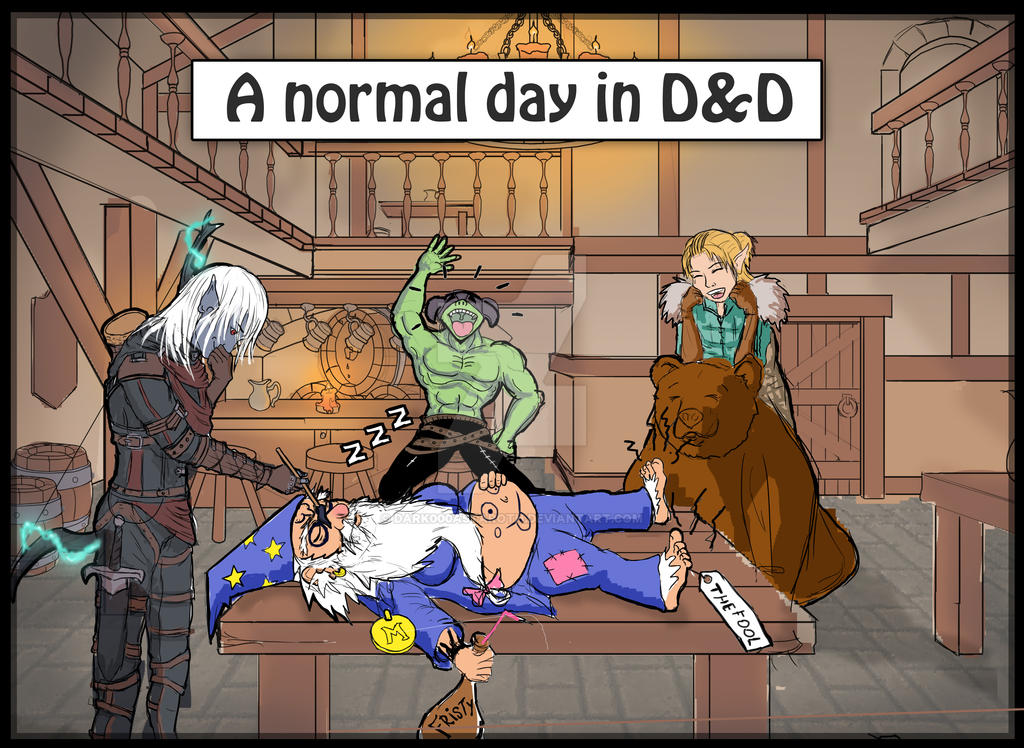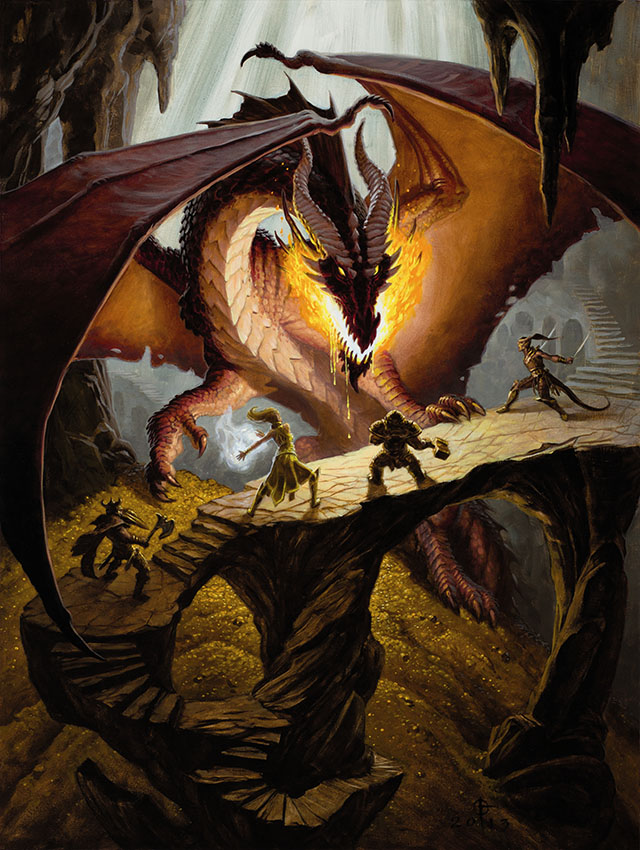This past year, I’ve been playing Dungeons and Dragons – quite possibly the nerdiest game in the world. However it’s reintroduced me to a human part of game design that we tend to forget when working on video games. There’s just something about sitting across the table from your friends and seeing the reaction on their face when you switch the gold chalice with a baked potato in the arms of a sleeping dragon. Or when you are almost melted by said dragon’s fire breath and are clinging to life by one hit point. Tabletop games give us a kind of immediate feedback that all game designers should crave.
If you’ve never played a tabletop role playing game, here’s how it works. A bunch of friends sit around a table to tell a story together. One of them is the Game Master (GM), and the rest are players. It’s the GM’s job to describe the world to the players and make it feel real. The players can attempt to do anything they want – yes anything – and they roll some dice to find out if they succeed or fail. Then the GM explains to the players what happened as a result. That’s pretty much the entire game. Yes there are $50 rule books, painted miniatures, and pages of races, classes, spells, magic items, etc. but it all boils down to a bunch of friends ordering pizza and using their imaginations. It’s a game where everything’s made up and the points don’t matter.

And yes, if you’re friends are anything like mine, it can quickly deteriorate into an episode of Whose Line is it Anyway. But there is actually a very good game design lesson to be learned from improv.
The Value of Immediate Feedback
So you’ve been working on that game design doc for months. You have pages of weapon tables, creature stats, items, NPCs, backstory. It’s going to make Steam’s top 100 in the first week, and people will love it!
But will they really?
The truth is no matter how skilled a designer you are, you won’t know until you let people get their hands on it. Untested designs are risky, and improv is a great tool to test your designs. A good GM will plan ahead, but be ready to roll with it when the players take the game off the rails.
Here’s an example that could be from Dungeons and Dragons:
GM: You enter a town of sullen houses under a stormy sky. The sign of a tavern squeaks in the wind. Ahead the path winds up a steep hill to a black castle. The jagged edges of towers are silhouetted against gray clouds that seem to swirl around it as if by a magical presence. What do you want to do?
Player: I want to find a barber shop. I need a haircut.
GM: Um… sure… [Now we’re off the rails] You look around town for a while and you find a building with a striped barber’s pole outside. You open the door and a very thin man sleeping in the barber’s chair. The door slams! “Oh!” He wakes up and jumps behind the counter. Then he peeks his head over. “Who’s there?”
Player: “I’m Gobblox and I need a haircut. What’s your name?”
GM: Um… “I’m… Dave! Dave the barber!”
Here the GM had a plan – to take the players to the spooky castle. But the players had something else in mind. The GM had to quickly adapt and invent a whole new character on the fly. Will the players like this NPC? As I’m writing this, I have no idea. That’s because I have not tested this NPC with real players. But in the example, the GM is about to find out wether the players enjoy the interaction with this NPC or not. Already the GM sees a wry smile on the player’s face. Gobblox is a hulking Half-Orc with a trickster’s sensibility. Let’s see how the interaction goes.
Player: I sit down in the chair without even asking.
GM: You sit down on the chair with a hearty *thud* and Dave sinks a little lower behind the countertop. Now he’s just a nose and glasses behind two knuckles. And he says, shaking, “I don’t get many customers… your size.”
Player: “Well, you’ve got one now! Get to it.”
GM: “Right! … sorry.” Dave emerges from behind the counter and laughs nervously, and then quickly goes to his drawers to get his supplies. You can see from the back – he is just skin and bones. His pants are almost falling off from how skinny he is.
Player: Is there a towel nearby?
GM: Yeah. You can grab a towel.
Player: I grab a towel and just whip him on the butt.
GM: “EEK!” He turns around… Make a sleight of hand check.
Player: [rolls dice] … 4.
GM: He sees you holding the towel and just grinning uncontrollably. “Well, isn’t that nice.” He smiles sheepishly behind his pencil-thin mustache.
Player: Haha. Awesome 🙂
Within a few minutes, the GM got to try out a new NPC idea and see the player’s immediate response. The player enjoyed playing a prank on this frail nervous barber. He will probably remember this NPC and want to interact with him again.
In my experience, some of the most memorable moments are the ones the GM didn’t plan.

So where can I get this “D and D”?
If you’re a game designer, I’d recommend just jumping into a game of D&D as a player and see what it’s all about. There are game shops in every city that hold D&D games on Wednesday nights, so it isn’t that hard to find a group. As a player, you’ll be able to see the immediate feedback on your own actions, and really just get in touch with your own improv abilities.
A whole new world opens up when you decide to try GM’ing. Being a GM lets you play the role of the game itself. It’s scary at first, knowing the players could throw anything your way. But it is also very rewarding. As a game designer, it lets you try out different design ideas in a way that you just can’t get at the computer screen. And if an idea isn’t working, you can adapt it on the fly. Afterwords you can ask your players what worked and what didn’t. It can be a great proving grounds for your ideas, as well as good practice for the skill of making stuff up 🙂
